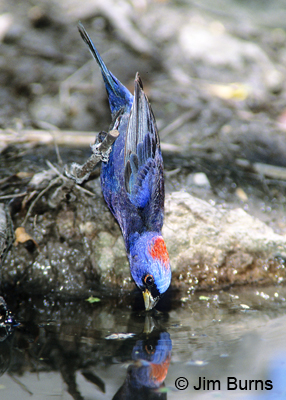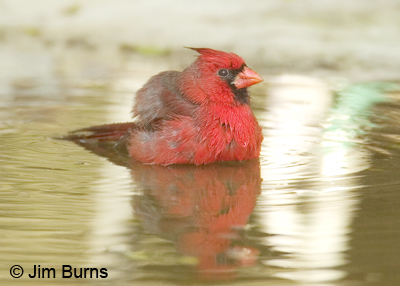
Spring in July? You thought spring in the desert arrived in February, but you're just focused on the thermometer, and you're not a bird. Think about it! The federal government may have arbitrarily designated June 15 as the beginning of the Southwest's so-called monsoon season, but we haven't seen appreciable rainfall since April, and we won't until the monsoon really begins, hopefully sometime this month. May and June are "fire season" for a reason. Everything dries out and there's not much water anywhere, but I guarantee you the birds will find it.
Summer for desert birders begins with the contests to predict the first 100 degree day. Summer for desert birds begins with the monsoon rains which bring life supporting moisture back to their desert habitat. Desert species such as Varied Buntings and Botteri's Sparrows don't even nest until the monsoon begins. The dearth of water in late May through June transforms typically elusive birds into a captive audience. Find a waterhole at this season, sit quietly and wait instead of "beating the bushes," and you'll be seeing birds in a new and exciting way--as feather studies rather than subjects in habitat.
Okay, so where's the water now? For starters, don't neglect your yard. Even if you don't have a water feature or a birdbath, you can create a few mini oases by suspending homemade plastic milk carton drips from tree branches. Make a depression in the ground beneath the drip, line it with vinyl, and place a few very short rocks in the gathering water. You may attract hummingbirds, Verdins, Lesser Goldfinches, or even desert woodpeckers to drink and bathe. Don't forget that the sound of water is a major draw for passing birds. I've enhanced some of my favorite waterholes for photography purposes by playing a tape of falling water.
Farther afield seek water where you normally see it, particularly along seasonal run-offs and creeks. Think Queen Creek in Boyce Thompson Arboretum or Madera Creek in the Santa Ritas south of Tucson for example. Birds come to these sources in other seasons but aren't concentrated because there's water everywhere. Now, just before the monsoon, many of these "flow" only underground and are reduced above ground to a few widely scattered pools. It may take some hiking to find these isolated "bathtubs," but every living thing in the neighborhood from mice and bunnies to deer and bobcats will show up sooner or later.
On June 23, 1996, at the very height of Arizona's most recent drought (which despite two relatively wet winters may still be ongoing), I sat by an isolated pool along Madera Creek and tallied 59 species of birds in two hours without moving--roadrunners drinking, warblers bathing, even Five-striped Sparrows which had never been seen that far north of the border.
Take snacks and a good book and just sit. If you find a good waterhole and you're wearing camouflage or even dark, non-reflective clothing, you won't even need binoculars. Don't forget to bring water. You probably won't want to drink out of the birds' waterhole but, just like your avian friends, you're going to need water at this time of year.